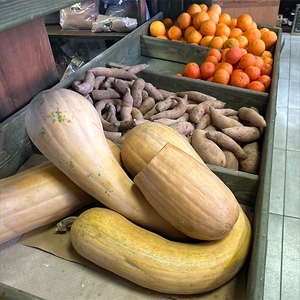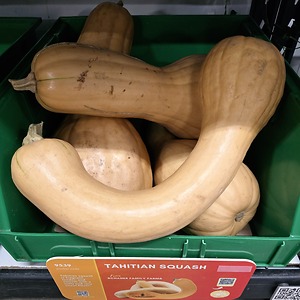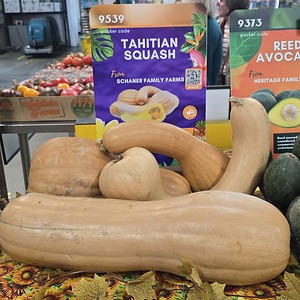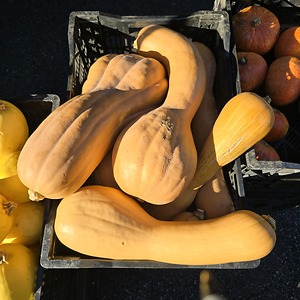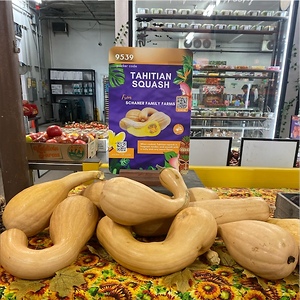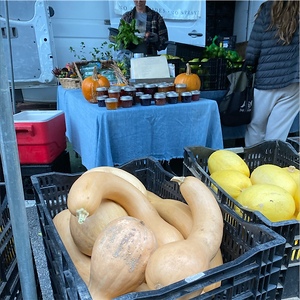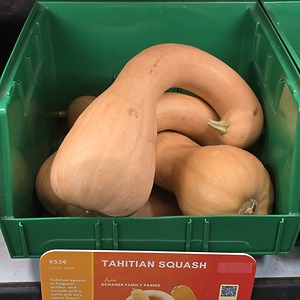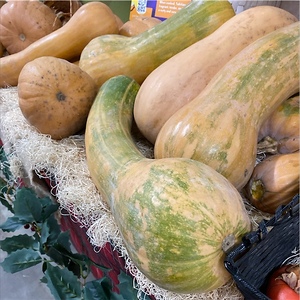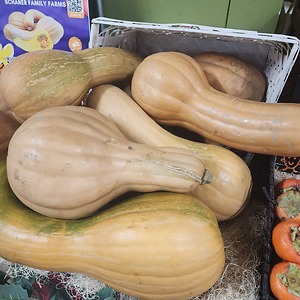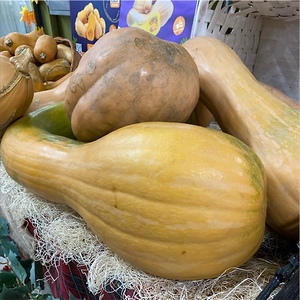

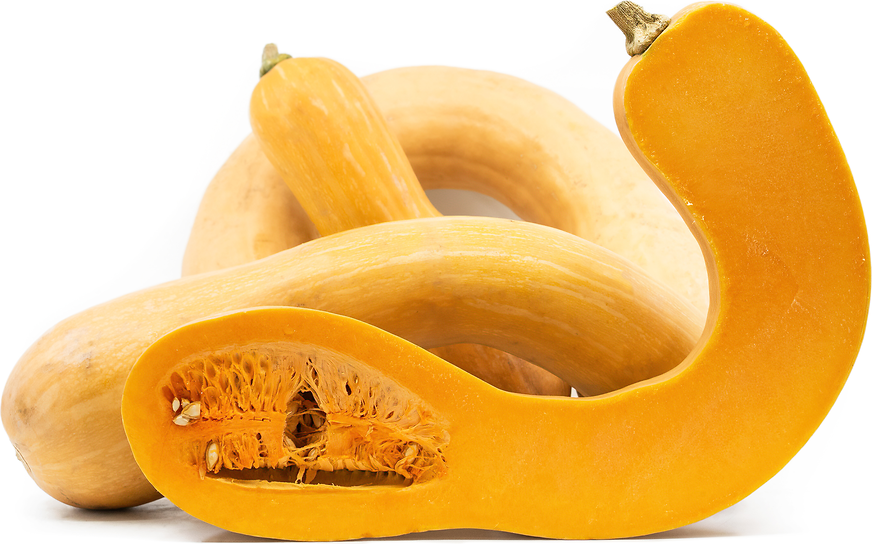
Tahitian Squash
Estimated Inventory, lb : 0
Description/Taste
Tahitian squash is a medium to large-sized variety that typically measures 40 to 50 centimeters in height and weighs between 3.5 to 18 kilograms. It resembles a large and elongated Butternut squash with a distinctive S-shaped curve at the top that's similar to Crookneck squash varieties. Tahitian squash has a hard light orange-tan rind that connects to a small light brown stem. This rind has lengthwise furrows, a smooth texture, and a glossy sheen. Tahitian squash flesh is thick, firm, dry, and has a rich orange hue. This flesh surrounds a hollow seed cavity in the bulbous end of the vegetable that contains stringy pulp and many flat cream-colored seeds. When cooked, Tahitian squash is fragrant, tender, and smooth with a nutty and distinctly sweet flavor.
Seasons/Availability
Tahitian squash is available from late summer to early winter.
Current Facts
Tahitian squash is botanically classified as Cucurbita moschat and belongs to the Cucurbitaceae family along with pumpkins, gourds, and cucumbers. This variety is also referred to as Tahitian melon and Tahitian Butternut squash. It's technically classified as a fruit but is often referred to and treated as a vegetable in cooking. This vegetable grows on large climbing vines that can produce over 45 kilograms of squash in one season that vary considerably in size and shape. Tahitian squash is a relative of Butternut squash and is known as one of the highest sugar and longest storing Winter squash varieties. Even when sliced up, the Tahitian squash will develop a hard skin on the cut end of the remaining flesh which allows it to be preserved for future use.
Nutritional Value
Tahitian squash is rich in vitamins A and C. These vitamins support immune function, promote healthy skin, and aid in vision. Vitamin C is also known for its role in collagen production, iron absorption, inflammation reduction, wound healing, and protection from free radical cell damage. This squash also provides significant amounts of magnesium and potassium, both of which are vital for maintaining proper muscle function, regulating blood pressure, and supporting cardiovascular health. Tahitian squash is a good source of calcium, which is crucial for strong bones and teeth, and fiber, which aids in digestion, helps maintain healthy cholesterol levels, and promotes satiety that can support weight management.
Applications
Tahitian squash is suited for both raw and cooked applications such as roasting, baking, grilling, steaming, sautéing, and boiling. The large size of this vegetable can be managed by slicing it into portions, using part of it for a recipe, and sealing the rest for later. Tahitian squash may be used raw in salads or cubed, cooked, and added to risotto, gnocchi, tacos, pizza, and ravioli. It can also be cooked and puréed for soups, curries, pies, puddings, sauces, breads, cakes, and muffins. When baked, Tahitian squash will have a stringy texture similar to Spaghetti squash. When roasted, the sugars in the flesh will caramelize to create a rich and decadent flavor. Tahitian squash pairs well with apples, butter, ricotta, aged cheeses, nuts, pears, chiles, curry, rosemary, cinnamon, citrus, chorizo, bacon, and poultry. Tahitian squash will keep for up to nine months when stored in a cool and dry place. This variety is not recommended for refrigeration as the cold temperatures cause the sugars to convert into starch and the vegetable to lose flavor.
Ethnic/Cultural Info
Tahitian squash didn't fully originate in Tahiti but its seeds are thought to have been brought there by European explorers. The first explorer to reach the island was British Captain Samuel Wallis in 1767. He called it King George the Third's Island after the reigning king. Captain James Cook arrived soon after to observe the transit of Venus, as Tahiti was considered the best place for these observations. While Cook’s findings were less accurate than he had hoped, European expeditions such as his introduced many new crops to Tahiti and the rest of French Polynesia. This included watermelons, oranges, lemons, limes, and the vegetable that eventually became known as Tahitian squash. This crop was cultivated and developed for some time before making its way back to Europe and the Americas in the 1960s.
Geography/History
Tahitian squash is a descendant of the squash species that originated in Central and South America. This variety grows in tropical and subtropical climates with high sun exposure and temperatures between 21 and 35 degrees Celcius. Tahitian squash is a cultivated variety that’s bred for its unique curly shape and sweet flavor. It's most often sown by farmers and home gardeners. Tahitian squash seeds were originally brought to Tahiti by European explorers and traders along their expedition routes. They introduced many New World squashes that would later be cultivated and developed into unique varieties like Tahitian squash. In the 1960s, an American sailor named George Patton acquired seeds of this cultivar from the Tahitians and brought them back to the Lucerne Valley, where he developed them throughout the 1970s. A British seed company called Thompson and Morgan also obtained Tahitian squash seeds and introduced them under the name Melon squash in 1977. Today, Tahitian squash is a niche variety that may be occasionally found at farmers' markets, specialty stores, and through online seed catalogs in Europe, the United States, Asia, and French Polynesia.
Recipe Ideas
Recipes that include Tahitian Squash. One
| Veggie's Don't Bite |
|
The Ultimate Creamy Winter Squash Soup |
| Tasty Eats At Home |
|
Tahitian Squash Risotto |
| Of The Dirt |
|
Tahitian Squash and Drunken Apple Pie |



